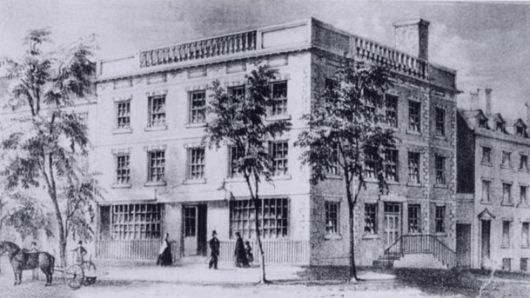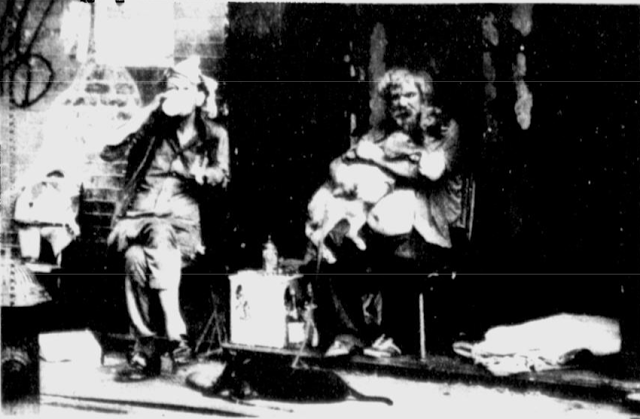Looking at the Lower East Side’s Presidential Connections
From the ambitious political architects of our fledgling nation to the most powerful heads-of-state of the 21st century, the Lower East Side has hosted some pretty interesting presidential history. Former Continental Army Commander George Washington was inaugurated as the first President of the United States during a ceremony at Federal Hall in Lower Manhattan on April 30, 1789. After what I’m sure was a night on the town that would...
On this day in 1981, The “Bowery Slasher” begins targeting homeless men
Charles Sears during arrest (NYS Digital Library) On the night of June 27, 1981, a 32-year old man named Charles Sears began targeting Manhattan vagrants in a slashing spree which spanned ten days and claimed fifteen victims -- two of whom died from the attacks. Sears, a Vietnam Veteran with a long criminal record, was estranged from his Bronx-based family and unemployed. By June of 1981 he found himself residing...
“Little Hungary” restaurant
Here is some memorabilia from the Little Hungary restaurant, formerly at 255-263 East Houston Street. A century ago it was one of the most famous restaurants in NYC, situated along what was once known as "Goulash Row." Teddy Roosevelt often dined there as police commissioner and made a promise to return if elected president. Keeping his word, Little Hungary made the national news and thereafter became a popular tourist destination.
David Sarnoff alerted the world of the Titanic disaster.
From a transmitter perched upon the roof of the old Wannamaker's Department Store in Astor Place, Lower East Side bred media pioneer David Sarnoff, who Time called the "Father of Broadcasting," made history by relaying up-to-the minute news of the tragic ocean liner sinking. Russian-born David Sarnoff (1891–1971), immigrated to the Lower East Side with his impoverished family at about nine years old. Like many neighborhood youths at the turn...
Ahoy? The St. Mark’s Place Navy
From The Villager, 3/1/12 By Eric Ferrara In February of 1891, a 35-year old German man named Christian C.W. Grassman arrived in New York City and quickly established himself in the real estate field. By the turn of the century he had co-founded the Grassman and Hirtz real estate company, located on the first floor of 94 St. Mark’s Place. The eccentric immigrant became a regular fixture in the neighborhood,...
Village’s ‘Little Hall of Fame’ had a memorable run
From The Villager, 2/22/12 Called the “Old Village’s Most Famous Exhibit” by The New York Times when it closed in August of 1913, Britting’s was a popular dining spot known for its extensive display of playbills, portraits, autographs and theater memorabilia dating back to the 18th century.READ FULL ARTICLE: http://www.thevillager.com/?p=2416
Prison to Pad Thai, Bleecker building has seen it all
From The Villager, 2/16/12, by Eric Ferrara On the afternoon of Feb. 24, 1813, at the height of the War of 1812, the U.S.S. Hornet, an 18-gun warship, set its sights on a British sloop anchored on the Demerara River in Guyana, South America. While navigating a sandbar at the river’s mouth to position itself for an attack, the Hornet found itself sandwiched between two enemy ships as the man-o’-war...
A Tale of Two Manhattan Islands, from The Villager
Suspected sites of locations discussed in the article. From LESHP director Eric Ferrara's new column in The Villager newspaper: A footnote in James Fenimore Cooper’s 1821 Revolutionary War-inspired novel The Spy declares, “Every Manhattanese knows the difference between ‘Manhattan Island’ and ‘the Island of Manhattan.’” If you visited the city two centuries ago, you had better have known the difference as well, lest you arouse the suspicious ire of a...
40 years later: Remembering Rocco Laurie and Gregory Foster
9th Precinct police officers Gregory Foster and Rocco Laurie On the night of January 27, 1972, rookie NYPD officers Rocco Laurie and Gregory Foster were ambushed while on patrol along Avenue B at East Eleventh Street. Only recently joining the police force after a stint as combat marines in Vietnam, Laurie and Foster were approached from behind by a group of individuals who opened fire on the unsuspecting pair. The...
The Lower East Side immigrants who influenced Hollywood
Some of the most tangible and significant contributions that turn-of-the-century European immigrants provided the world were in the field of entertainment and the Lower East Side has spawned some of the most accomplished film producers, directors, actors and composers in the medium's century-long history. In fact without the influence of these early immigrants and their offspring, the motion picture industry as we know it would be very different today. Screen...
Map: Churches of the Lower East Side, 1877
Click for larger map By the turn of the twentieth century, the abundance of houses of worship on the Lower East Side rivaled any district on the planet. The map above highlights the neighborhood's churches by 1877 (synagogues will be explored in a future post). Many more churches and chapels were erected in the following three decades as Catholic Italians, Orthodox Ukrainians and others began immigrating in large numbers. Old...
Industrial Lower East Side, part 2: The 11th & 13th Wards, 1891
For well over a century, the Lower East Side's waterfront hosted Manhattan's primary industrial district. Among dozens of factories and horse stables was one of the largest concentrations of coal, lumber and iron yards in the city. This map illustrates some of the larger companies operating by 1891, in the 11th and 13th Wards of the Lower East Side. See "Alphabet City" in 1891: http://les360.org/2011/12/industrial-alphabet-city-1891/
“Perambulating Fountains” of the Lower East Side
Source: Directory of New York Charities, 1900 You are probably asking yourself, "What on earth is a 'perambulating fountain'?" Source: Directory of New York Charities, 1900 Well, if you lived on the Lower East Side at the turn of the century, you would probably be very familiar with its common term, "ice-water fountain." Before refrigerators, running taps in every apartment and public fountains -- let alone bottled water -- there...
How crowded was the Lower East Side?
In the decades following the Revolutionary War, opportunists from across the globe poured into New York City seeking fortune in the Capital of the newly formed United States of America. Anticipating a major growth in population, the modern day street grid was established in 1811, opening up two-thirds of previously uninhabitable Manhattan real estate. As industry boomed, the city (perhaps conveniently) opened its doors to laborers, Irish and German immigrants,...
Industrial Alphabet City, 1891
Based on 1891 G. W. Bromley map For well over a century, the Lower East Side's waterfront hosted Manhattan's primary industrial district. Among dozens of factories and horse stables was one of the largest concentrations of coal, lumber and iron yards in the city. This map illustrates some of the larger companies operating by 1891, in the neighborhood referred to now by many as "Alphabet City." By WWII most of...
Rare photos of the legendary Steve Brodie
Outside 114 Bowery c. 1897 (left), scan of Brodie's 1896 liquor license (right)These are some rare images relating to Steve Brodie, a man whose claim to fame was just that, a claim, that in 1886 he jumped from the Brooklyn Bridge and survived.The following an excerpt from The Bowery: A History of Grit, Graft and Grandeur: Brodie, a native Lower East Sider, was an outgoing, blusterous youth who earned the...
1897 Saloon Locations in the “Jewish Quarter”
Here is a crude map of bar locations in the LES "Jewish Quarter" in 1897. There was one bar for every 208 people living the the neighborhood.
Lord & Taylor on the Lower East Side
Did you know that Lord & Taylor got its start on the LES? The flagship store was at 63 Catharine Street (pictured left), its next on the corner of Grand and Chrystie Streets (pictured, right).
Brooks Brothers First Store on the Lower East Side
Did you know that Brooks Brothers, America's oldest mens retail store, got its start on the Lower East Side? These images are from its original store on the corner of Catharine and Cherry Street -- which opened in 1818! It moved from this location to Broadway and Grand Street in the late 1850s.
Steinway & Sons on the Lower East Side
Did you know that Steinway & Sons was once located on the Lower East Side?Though German immigrant Heinrich Steinway founded in the iconic company 1853 out of a small shop at 75 Varick Street, his sons opened an upscale showroom at 107-109 E. 14th Street in 1864.In 1866, they opened Steinway Hall in the rear of the showrooms, which quickly became the center of New York City's cultural elite. The...

